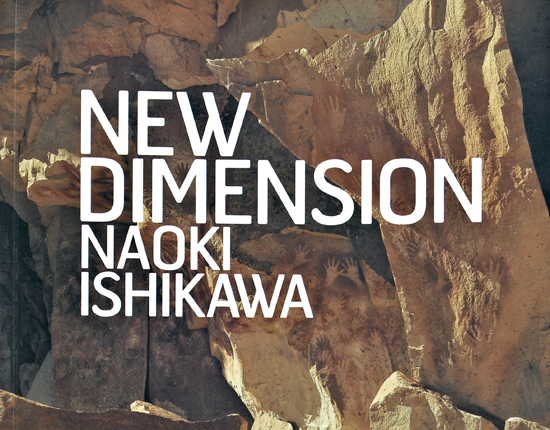| SIMON DENISON IMAGE & TEXT |
| PREVIOUS | NEXT |
NEW DIMENSION Naoki Ishikawa Akaaka Art Publishing, 2007 ISBN 978-4-903545-18-9 Pb
Prehistoric art on the walls of caves and rock shelters has astounded audiences ever since it was first discovered by modern Europeans at sites in northern Spain and southern France in the late 19th century. One would need a heart of stone not to be haunted by the mystery, exquisite draughtsmanship and great antiquity of many of these sites – around 30,000 years old in the case of the recently-discovered Chauvet Cave in France, with Late Upper Palaeolithic (as well as much more recent) examples found across the world from Patagonia to India and Australia. The first appearance of art, both on rock walls and as portable carvings, coincides with the global spread of fully modern humans. The creators of this work, in other words, were not the grunting cavemen of cartoons but people like us, who looked like us, who spoke and made music, and were as intelligent and resourceful and foolish and thoroughly individual as we are. It is perhaps this sense of contact with people we might recognise across unimaginable aeons, and the numbing realisation of our own place in the sweep of time that lends such compelling appeal to these prehistoric images – and rarely more so than with the stencils of hands made at numerous sites across the world, some of which are depicted here. These stencils represent something more than signs of ancient human activity and creativity; they provide direct material traces, like bloodstains or footprints, of the people who once stood against the rock blowing ochre over their outstretched fingers. Naoki Ishikawa, a Japanese mountaineer turned photographer, has approached some of these rock art sites on several continents with all the awe and wonder you’d expect of any sentient human being. ‘When I stand before cave paintings, I feel I have come into contact with an aspect of primordial consciousness,’ he writes. He also follows a long tradition of artists wishing to engage visually with their feelings about ancient sites, from 18th century watercolourists on their Grand Tour in Italy to British artists of the 20th century such as Paul Nash, Edwin Smith and Bill Brandt, whose ancient subject matter acted as symbols for a range of visions about the contemporary world. The best of this work – Brandt’s oppressively darkened looming megaliths at Stonehenge, for example – gains its power by taking advantage of certain inherent characteristics of the visual medium to express the artist’s ideas in a way that can be shared by a wider audience. Unfortunately, there is little of that sort of power to be seen in this book. Ishikawa’s photographs of petroglyphs and paintings are straightforwardly descriptive, of exactly the type that might be taken by any competent tourist-photographer with a digital SLR. Dozens of pictures similar to these have been published in textbooks on prehistoric art. The only difference here is that Ishikawa combines his pictures of the art with contextual images representing his journeys to each of the rock art sites. These consist of a collection of landscapes, people, animals and objects encountered en route, a mountainside here, some local boys acting up for the camera there, a dog with a sore here, some wet grass there. Some of these are moderately diverting. Some of the live animal pictures inform us that some species of animals depicted in the art still inhabit the local landscape. Yes, there are still reindeer in Norway. We learn from the book’s essays that these contextual pictures are supposed to represent the artist’s mental journey from normality to epiphany, or some type of psychic transformation, as the rock art is encountered. But they are too random and unsurprising, and the images of the rock art too pedestrian, to achieve that effect. One might wonder whether it is even possible to represent a subtly unfolding psychic journey through still photography. Some, like Garry Fabian Miller or Thomas Joshua Cooper, have managed to evoke the contemplative state, even perhaps the metaphysical objects of their contemplation, but not, I think, the journey to reach that state, and never through straight photography. The imaginative combinations of text and imagery that we find in, say, Hamish Fulton’s artwork journeys might have offered some additional clues. But Ishikawa has played it straight and missed his chance. Nobody knows, of course, why prehistoric rock art was made. People will have had different motivations at different times and places. But the predominance of images of prey animals suggests that sympathetic magic may have been an important part of much of it; that to depict the animal, the hunter gained some power over it, some form of possession of it. This idea, seen also in the curse doll, is curious for a photographic audience as a similar explanation has been given for the appeal of photography itself, especially photography of people and places dear to us – those photographs we keep on our desks and in our wallets and albums. Tourists also dabble with sympathetic magic, for as Susan Sontag pointed out, they ‘put the camera between themselves and whatever is remarkable that they encounter’. Instead of engagement and experience, they consume. By making the picture, they imagine perhaps that they are gaining lasting possession over the thing photographed. Ishikawa, writes the art historian Toshiharu Ito, ‘took photographs in the way that people painted on rock surfaces’. Maybe he did. Out of a great fascination with these sites, he hunted them down like prey, and in taking his pictures he has perhaps satisfied some craving he had to possess them. One can only hope he has. Yet as the overpainting of many prehistoric images in French and Spanish caves suggests, it was the act of making the images that mattered, that held some potency – not the experience that others might have in looking at the images after they have been made. |
 |
|---|---|